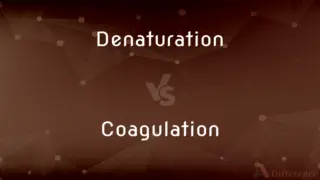Ideal Standards vs. Practical Standards — What's the Difference?
By Tayyaba Rehman — Published on October 1, 2023
Ideal Standards represent perfection and optimal conditions, while Practical Standards account for real-world conditions and limitations.

Difference Between Ideal Standards and Practical Standards
Table of Contents
ADVERTISEMENT
Key Differences
Ideal Standards serve as a pinnacle of excellence, aiming to define the best possible outcome or method in any given situation. These standards often represent the absolute best-case scenarios, discounting any inefficiencies or unexpected events. Their function is to provide an aspirational target. On the contrary, Practical Standards are grounded in reality.
Practical Standards acknowledge the challenges and imperfections inherent in real-world processes and environments. While they may not represent perfection, they are achievable and take into account potential hiccups, inefficiencies, or errors. When we speak of Ideal Standards, we envision an environment devoid of any potential pitfalls or constraints.
When comparing the two, it's evident that while Ideal Standards paint a picture of "what could be" in perfect circumstances, Practical Standards offer a more attainable and actionable goal, one that can be reached given current circumstances and limitations. An organization or individual might set Ideal Standards as a distant objective, but day-to-day operations would likely hinge on Practical Standards.
The choice between Ideal and Practical Standards often depends on the context. In research or theoretical endeavors, Ideal Standards can serve as a guide to push boundaries. However, in operational settings or where resources are limited, Practical Standards are more fitting as they ensure that targets are realistic and achievable.
Comparison Chart
Basis
Perfection and optimal conditions.
Real-world conditions and achievable outcomes.
ADVERTISEMENT
Achievability
May not be achievable.
Designed to be achievable within known constraints.
Consideration
Disregards real-world inefficiencies.
Accounts for potential challenges and inefficiencies.
Application
Aspirational targets.
Day-to-day operational targets.
Flexibility
Rigid and fixed.
More adaptable to changing conditions.
Compare with Definitions
Ideal Standards
Standards depicting the best possible outcome.
The laboratory's Ideal Standards demanded 100% accuracy in results.
Practical Standards
Feasible goals that account for potential inefficiencies.
By following Practical Standards, the project stayed on track.
Ideal Standards
Targets based on perfection, irrespective of feasibility.
In a world without resource constraints, their Ideal Standards would be achievable.
Practical Standards
Realistic and achievable benchmarks.
The manager set Practical Standards to ensure the team could meet them.
Ideal Standards
A benchmark representing optimal conditions.
The company set its Ideal Standards high, hoping to achieve perfection.
Practical Standards
Adaptable benchmarks that can adjust to changing conditions.
With changing market conditions, their Practical Standards evolved accordingly.
Ideal Standards
Theoretical benchmarks often unattainable in practice.
The team knew meeting the Ideal Standards would be a challenge.
Practical Standards
Targets set based on known conditions and constraints.
The factory operated based on Practical Standards to maintain steady production.
Ideal Standards
Standards disregarding any inefficiencies or real-world limitations.
While Ideal Standards can guide vision, they often overlook practical challenges.
Practical Standards
Standards that consider real-world challenges.
Given the limited resources, they shifted focus to Practical Standards.
Common Curiosities
Can Ideal Standards always be achieved?
Not necessarily; Ideal Standards often represent a best-case scenario which might be unattainable.
How do Practical Standards differ?
Practical Standards are grounded in reality, considering real-world conditions and constraints.
What do Ideal Standards represent?
Ideal Standards represent optimal outcomes or methods, aiming for perfection.
Are Practical Standards more realistic?
Yes, Practical Standards are designed to be achievable and consider potential challenges.
Can an organization use both types of standards?
Absolutely. Many organizations set Ideal Standards as visionary goals and Practical Standards for day-to-day operations.
Why might a company use Ideal Standards?
Ideal Standards can provide an aspirational target, motivating teams to strive for excellence.
Are Practical Standards more flexible?
Yes, Practical Standards can adapt to changing conditions or new information.
In what scenarios are Practical Standards preferred?
In daily operations or situations with known limitations, Practical Standards offer more attainable goals.
Do Ideal Standards change frequently?
Ideal Standards are typically fixed and rigid, representing a consistent vision of perfection.
Share Your Discovery

Previous Comparison
Binary vs. ASCII
Next Comparison
Denaturation vs. CoagulationAuthor Spotlight
Written by
Tayyaba RehmanTayyaba Rehman is a distinguished writer, currently serving as a primary contributor to askdifference.com. As a researcher in semantics and etymology, Tayyaba's passion for the complexity of languages and their distinctions has found a perfect home on the platform. Tayyaba delves into the intricacies of language, distinguishing between commonly confused words and phrases, thereby providing clarity for readers worldwide.











































